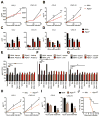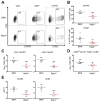RIPK3 Restricts Viral Pathogenesis via Cell Death-Independent Neuroinflammation
- PMID: 28366204
- PMCID: PMC5405738
- DOI: 10.1016/j.cell.2017.03.011
RIPK3 Restricts Viral Pathogenesis via Cell Death-Independent Neuroinflammation
Abstract
Receptor-interacting protein kinase-3 (RIPK3) is an activator of necroptotic cell death, but recent work has implicated additional roles for RIPK3 in inflammatory signaling independent of cell death. However, while necroptosis has been shown to contribute to antiviral immunity, death-independent roles for RIPK3 in host defense have not been demonstrated. Using a mouse model of West Nile virus (WNV) encephalitis, we show that RIPK3 restricts WNV pathogenesis independently of cell death. Ripk3-/- mice exhibited enhanced mortality compared to wild-type (WT) controls, while mice lacking the necroptotic effector MLKL, or both MLKL and caspase-8, were unaffected. The enhanced susceptibility of Ripk3-/- mice arose from suppressed neuronal chemokine expression and decreased central nervous system (CNS) recruitment of T lymphocytes and inflammatory myeloid cells, while peripheral immunity remained intact. These data identify pleiotropic functions for RIPK3 in the restriction of viral pathogenesis and implicate RIPK3 as a key coordinator of immune responses within the CNS.
Keywords: RIPK1; RIPK3; West Nile virus; chemokines; necroptosis; neuroimmunology; neuroinflammation.
Copyright © 2017 Elsevier Inc. All rights reserved.
Figures







Comment in
-
A RIPtide Protects Neurons from Infection.Cell Host Microbe. 2017 Apr 12;21(4):415-416. doi: 10.1016/j.chom.2017.03.014. Cell Host Microbe. 2017. PMID: 28407477
-
RIPped for neuroinflammation.Cell Res. 2017 Sep;27(9):1081-1082. doi: 10.1038/cr.2017.75. Epub 2017 May 19. Cell Res. 2017. PMID: 28524164 Free PMC article.
-
Host response: Neurons loosen the gRIP of death.Nat Microbiol. 2017 May 22;2:17090. doi: 10.1038/nmicrobiol.2017.90. Nat Microbiol. 2017. PMID: 28530667 No abstract available.
Similar articles
-
Chemokine Receptor Ccr7 Restricts Fatal West Nile Virus Encephalitis.J Virol. 2017 Apr 28;91(10):e02409-16. doi: 10.1128/JVI.02409-16. Print 2017 May 15. J Virol. 2017. PMID: 28356527 Free PMC article.
-
IL-1β signaling promotes CNS-intrinsic immune control of West Nile virus infection.PLoS Pathog. 2012;8(11):e1003039. doi: 10.1371/journal.ppat.1003039. Epub 2012 Nov 29. PLoS Pathog. 2012. PMID: 23209411 Free PMC article. Clinical Trial.
-
The neurotoxicant PCB-95 by increasing the neuronal transcriptional repressor REST down-regulates caspase-8 and increases Ripk1, Ripk3 and MLKL expression determining necroptotic neuronal death.Biochem Pharmacol. 2017 Oct 15;142:229-241. doi: 10.1016/j.bcp.2017.06.135. Epub 2017 Jul 1. Biochem Pharmacol. 2017. PMID: 28676433
-
The Inflammatory Signal Adaptor RIPK3: Functions Beyond Necroptosis.Int Rev Cell Mol Biol. 2017;328:253-275. doi: 10.1016/bs.ircmb.2016.08.007. Epub 2016 Sep 22. Int Rev Cell Mol Biol. 2017. PMID: 28069136 Free PMC article. Review.
-
Complex Pathologic Roles of RIPK1 and RIPK3: Moving Beyond Necroptosis.Trends Pharmacol Sci. 2017 Mar;38(3):202-225. doi: 10.1016/j.tips.2016.12.005. Epub 2017 Jan 23. Trends Pharmacol Sci. 2017. PMID: 28126382 Free PMC article. Review.
Cited by
-
The Nucleotide Sensor ZBP1 and Kinase RIPK3 Induce the Enzyme IRG1 to Promote an Antiviral Metabolic State in Neurons.Immunity. 2019 Jan 15;50(1):64-76.e4. doi: 10.1016/j.immuni.2018.11.017. Epub 2019 Jan 8. Immunity. 2019. PMID: 30635240 Free PMC article.
-
RIPK3 promotes neuronal survival by suppressing excitatory neurotransmission during CNS viral infection.bioRxiv [Preprint]. 2024 Apr 28:2024.04.26.591333. doi: 10.1101/2024.04.26.591333. bioRxiv. 2024. Update in: Immunity. 2025 Mar 11;58(3):666-682.e6. doi: 10.1016/j.immuni.2025.01.017. PMID: 38712188 Free PMC article. Updated. Preprint.
-
RIPK1 activation mediates neuroinflammation and disease progression in multiple sclerosis.Cell Rep. 2021 May 11;35(6):109112. doi: 10.1016/j.celrep.2021.109112. Cell Rep. 2021. PMID: 33979622 Free PMC article.
-
Crashing the computer: apoptosis vs. necroptosis in neuroinflammation.Cell Death Differ. 2019 Jan;26(1):41-52. doi: 10.1038/s41418-018-0195-3. Epub 2018 Oct 19. Cell Death Differ. 2019. PMID: 30341422 Free PMC article. Review.
-
Dectin-1-induced RIPK1 and RIPK3 activation protects host against Candida albicans infection.Cell Death Differ. 2019 Dec;26(12):2622-2636. doi: 10.1038/s41418-019-0323-8. Epub 2019 Apr 3. Cell Death Differ. 2019. PMID: 30944411 Free PMC article.
References
-
- Beisner DR, Ch’en IL, Kolla RV, Hoffmann A, Hedrick SM. Cutting edge: innate immunity conferred by B cells is regulated by caspase-8. J Immunol. 2005;175:3469–3473. - PubMed
-
- Berger SB, Kasparcova V, Hoffman S, Swift B, Dare L, Schaeffer M, Capriotti C, Cook M, Finger J, Hughes-Earle A, et al. Cutting Edge: RIP1 kinase activity is dispensable for normal development but is a key regulator of inflammation in SHARPIN-deficient mice. J Immunol. 2014;192:5476–5480. - PMC - PubMed
-
- Brien JD, Lazear HM, Diamond MS. Propagation, quantification, detection, and storage of West Nile virus. Current protocols in microbiology. 2013;31:15D 13 11–15D 13 18. - PubMed
MeSH terms
Substances
Grants and funding
LinkOut - more resources
Full Text Sources
Other Literature Sources
Medical
Molecular Biology Databases
Miscellaneous

